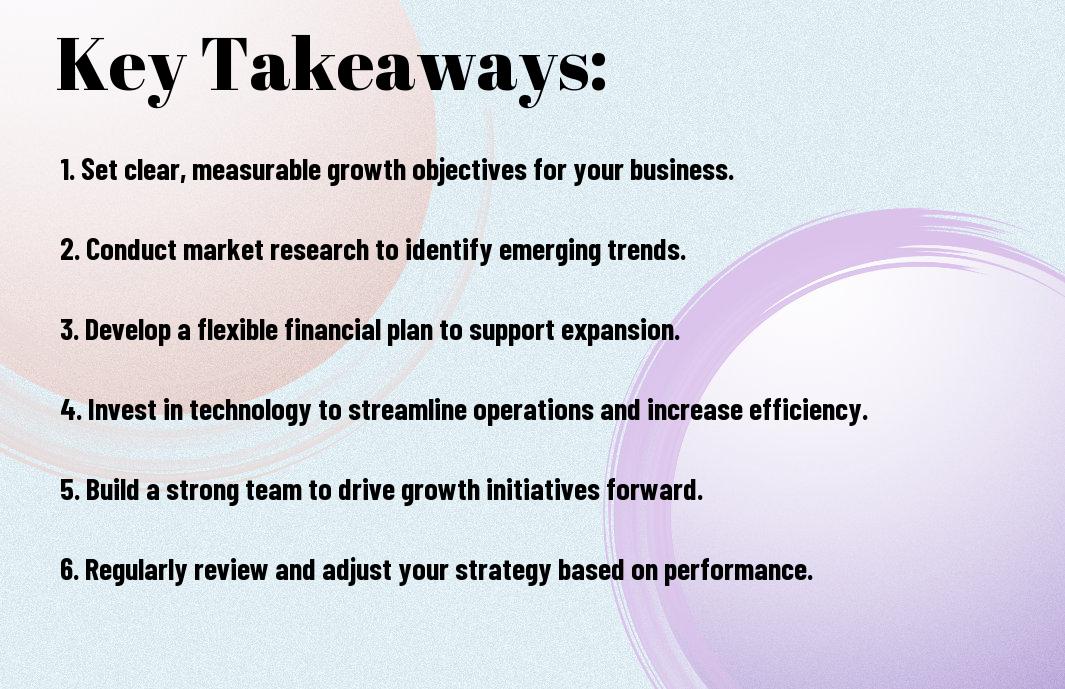Planning for your business’s future growth involves strategic thinking and proactive measures that align with your long-term vision. To effectively navigate this journey, you should assess your current operations, market trends, and competitive landscape. Implementing a structured plan can significantly enhance your chances of success. For guidance, check out these resources on How to Grow a Small Business in 10 Easy Steps, which provide practical steps to foster stability and growth.
Key Takeaways:
- Set Clear Goals: Define specific, measurable objectives that align with your long-term vision for growth.
- Monitor Market Trends: Stay informed about industry developments and adapt your strategies to meet changing customer needs.
- Invest in Technology: Leverage innovative tools and solutions to streamline operations and enhance productivity as you scale.

Assessing Current Business Position
Assessing your current business position is important to identify where you stand in your industry and what steps you need to take to achieve your growth objectives. Start by evaluating your resources, operations, customer base, and financial performance. This assessment will help you determine your strengths, areas for improvement, and opportunities emerging in your market, laying a solid foundation for your growth strategy.
Analyzing Strengths and Weaknesses
Above all, it’s important to conduct a thorough SWOT analysis to evaluate your strengths and weaknesses. Ask yourself what your business excels at and where you may fall short. By identifying these factors, you can leverage your strengths effectively and address your weaknesses to enhance your overall business performance.
Understanding Market Trends
Business growth also depends on your understanding of evolving market trends. Staying informed on industry shifts, consumer preferences, and technological advancements will inform your strategic planning. This awareness enables you to adjust your offerings and capitalize on emerging opportunities.
Position your business as an adaptable player in a dynamic marketplace by regularly researching and analyzing current and future trends. Follow industry news, engage in networking opportunities, and use data analytics tools to gather actionable insights. Understanding these trends not only helps you anticipate changes but also aids you in making informed decisions that align with customer expectations and market demands.
Setting Clear Goals
You must set clear and actionable goals to steer your business toward future growth. These goals will serve as a roadmap, helping you to stay focused and measure progress over time. Ensure that your goals are specific, measurable, achievable, relevant, and time-bound (SMART) to create a solid framework for success.
Defining Short-term Objectives
After identifying your long-term vision, it’s time to break this down into manageable short-term objectives. These objectives should span a timeframe of one year or less and be designed to attract quick wins that build momentum. By tackling smaller, specific goals, you create a clear pathway to achieving your overall vision.
Establishing Long-term Vision
Goals need to be forward-looking, focusing on where you want to be well into the future. This long-term vision will guide your strategic decisions and resource allocation. You should envision what success looks like for your business in five, ten, or even twenty years to ensure alignment with your core values and mission.
For instance, you may envision expanding your product line or entering new markets. This long-term perspective will not only inspire you but also your team, aligning everyone’s efforts towards a common future. Documenting this vision helps you stay accountable and can be a valuable tool for guiding day-to-day operations toward achieving those larger aspirations.
Identifying Growth Opportunities
Keep an eye out for growth opportunities within your industry by analyzing market trends, customer behaviors, and competitor activities. Surveying your customer base can provide valuable insights into unmet needs and potential areas for expansion. Additionally, leveraging data analytics tools can help you identify patterns and trends, guiding your strategic decisions for future growth.
Market Expansion Strategies
An effective approach to market expansion is to explore new geographical territories where your products or services can fulfill existing demand. This may involve tailoring your marketing strategies to suit local cultures or navigating regulatory requirements specific to each region to ensure a smooth entry.
Product Diversification Options
Along with expanding into new markets, consider diversifying your product line to attract a broader customer base. You can develop complementary products that enhance your current offerings or innovate entirely new items that meet emerging consumer needs.
Expansion into new product lines not only increases your market reach but also mitigates risks associated with reliance on a single product. By researching consumer trends and harnessing feedback from your clients, you can strategically develop products that address gaps in the market while staying aligned with your brand’s core values. Visibility in various product categories can also lead to improved customer loyalty as clients see you as a one-stop shop for their needs.
Financial Planning for Growth
Not having a solid financial plan can jeopardize your business’s potential for growth. To ensure sustainability and success, it’s vital to create a detailed financial strategy that encompasses budgeting, forecasting, and managing cash flow. This plan should account for not only current expenses but also future investments that will propel your business forward.
Budgeting for Expansion
Planning for expansion requires you to create a realistic budget that aligns with your growth objectives. Assess your operational costs, factor in new hires, equipment, and marketing expenses to ensure you allocate resources wisely. A well-structured budget allows you to identify potential challenges and adjust accordingly, putting you in a better position to seize growth opportunities.
Exploring Funding Options
Growth often necessitates exploring different funding options to support your expansion plans.
A diverse range of funding sources is available to assist you in financing your growth endeavors. Consider traditional loans, venture capital, equity financing, or even crowdfunding platforms, depending on your business’s specific needs and growth stage. Each option has its pros and cons, so be sure to evaluate them carefully, aligning financial support with your long-term business vision and ensuring it fits into your overall financial strategy.
Building a Scalable Infrastructure
All successful businesses must create a scalable infrastructure to accommodate future growth. This means designing systems and processes that can handle an increase in demand without compromising quality. As you explore your Growth Plan for the Future: Prepare Your Business in 5 Steps, focus on how to enhance your organizational structure and technology to support expansion efficiently.
Investing in Technology
At the heart of any scalable infrastructure lies smart technology investments. Adopting advanced tools and platforms can streamline various processes, making your business more agile and responsive to market changes. Whether it’s cloud solutions or automation software, these technologies will help you manage growth effectively, allowing you to serve clients better even as your audience expands.
Streamlining Operations
Before initiateing on your growth journey, assess your current operations to identify inefficiencies. Streamlining these processes can eliminate redundancies and improve productivity, creating a more responsive organization. Look for areas where you can consolidate tasks or implement automated solutions to free up resources for new opportunities.
Indeed, optimizing your operations not only saves time and money but also positions your business to scale seamlessly. Engage your team in the evaluation process; their insights can highlight practical improvements. Additionally, create a feedback loop to continuously refine processes, ensuring that your organization remains efficient as you grow. A focus on operational efficiency will empower you to seize new opportunities while maintaining a strong foundation for future success.

Developing a Strong Team
To achieve sustainable growth, it’s important to cultivate a strong team that aligns with your business’s vision and values. A well-rounded team not only enhances productivity but also fosters innovation and resilience within your organization. By investing in your people and creating a positive work environment, you set the stage for long-term success and adaptability as your business evolves.
Hiring Strategies
By implementing targeted hiring strategies, you can attract the right talent to support your business’s growth. Focus on defining clear job roles and desired qualifications that align with your organizational goals. Utilize a diverse range of recruitment channels, such as social media, job boards, and networking events, to broaden your reach and ensure you find the best candidates that fit your team dynamic.
Employee Development and Retention
For sustaining a strong team, investing in employee development and retention strategies is vital. Providing continuous learning opportunities allows your team to enhance their skills, making them more engaged and effective in their roles. Additionally, fostering an inclusive workplace culture promotes loyalty and reduces turnover, ultimately benefiting your organization’s long-term success.
To effectively enhance employee development and retention, implement regular performance evaluations and feedback sessions. Offer tailored training programs that cater to individual career goals and organizational needs. You should also prioritize work-life balance by promoting flexible working arrangements and recognizing employee achievements, which can significantly improve job satisfaction and reduce attrition rates.
Summing up
Presently, planning for your business’s future growth involves strategic thinking and proactive decision-making. You should assess your current position, set clear goals, and develop actionable strategies to achieve those objectives. Incorporating market analysis and customer feedback into your planning will help you adapt and thrive. Additionally, investing in technology and nurturing talent within your team can position your business for sustainable growth. Ultimately, by staying forward-thinking and adaptable, you can effectively navigate the complexities of growth and ensure your business’s long-term success.
FAQ
Q: What steps should I take to assess my current business position for future growth?
A: To effectively assess your current business position, begin by conducting a comprehensive SWOT analysis—this identifies your Strengths, Weaknesses, Opportunities, and Threats. Follow this up by analyzing your financial statements and performance metrics, enabling you to understand your profitability, cash flow, and revenue trends. Engage with your team to gather insights on operational efficiencies and customer feedback. This information will create a baseline from which you can formulate growth objectives.
Q: How can I identify potential areas for growth within my business?
A: Identifying potential areas for growth starts with market research. Analyze your industry trends, customer behaviors, and competitive landscape. Consider diversifying your product or service offerings to meet various customer needs or enter new markets. Look into partnerships and collaborations that can enhance your market reach. Additionally, leveraging customer data can help you understand preferences and areas where you may raise your offerings. Conducting regular assessments will keep you responsive to shifting opportunities.
Q: What role does setting measurable goals play in planning for business growth?
A: Setting measurable goals is vital for tracking progress and maintaining focus on your growth strategy. Specific, measurable, attainable, relevant, and time-bound (SMART) goals will offer clarity on your objectives and give your team clear targets to work towards. Regularly review these goals to assess achievement and make necessary adjustments. This keeps your team motivated and aligned, while also enabling you to celebrate milestones and learn from any setbacks as you move towards long-term growth.







